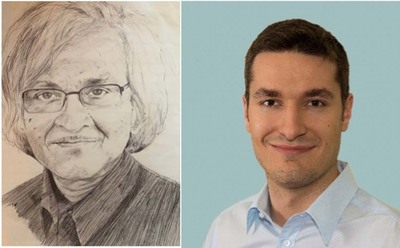ASCENT Theme 2: Probabilistic Computing: From Devices to Systems
 Supriyo Datta (L) and Jan Kaiser (R) Purdue University
Supriyo Datta (L) and Jan Kaiser (R) Purdue University
Application spaces for computing with p-bit
Presenters: Jan Kaiser and Supriyo Datta (Purdue)
Abstract: Digital computing is based on deterministic bits with two values, 0 and 1 which are often represented with stable magnets. On the other hand, quantum computing is based on qubits which are delicate superpositions of 0 and 1 and are represented with individual spins. Our group has been working on something in-between namely, p-bits, which are robust classical entities fluctuating between two values 0 and 1 [1].
In this talk, starting from the intrinsic physics of nanomagnets, we show that a compact hardware implementation of a p-bit based on stochastic magnetic tunnel junctions (s-MTJs) can operate at high-speeds in the order of nanoseconds, a prediction that has recently received experimental support.
We then move to the system level and illustrate by simulation and by experiment how multiple interconnected p-bits can be utilized to train a Boltzmann machine built with hardware p-bits. We show that even non-ideal s-MTJs can be utilized for probabilistic computing when combined with hardware-aware learning [2].
The rest of the talk will be focused on developing a generic architecture for p-computers that can address a wide variety of applications including but not limited to Bayesian networks, optimization, Ising models, and quantum Monte Carlo [3]. Results will be presented showing significantly improved performance with respect to state-of-the-art implementations on CPU and GPU.
[1] IEEE Spectrum https://ieeexplore.ieee.org/abstract/document/9393992
[2] SRC# P099355 https://journals.aps.org/prapplied/abstract/10.1103/PhysRevApplied.17.014016
[3] SRC# P103454 https://aip.scitation.org/doi/full/10.1063/5.0067927
ASCENT Theme 2 Task 2776.019:Theoretical Framework for Spintronics
Bio(s)
Supriyo Datta received his PhD from University of Illinois at Urbana-Champaign in 1979 and has been with Purdue University since 1981. The non-equilibrium Green function (NEGF) method pioneered by his group is widely used for the modeling of quantum transport in nanoscale devices. He is also known for innovative theoretical proposals that have inspired new fields of research including spintronics and negative capacitance electronics. https://nanohub.org/groups/supriyodatta
Jan Kaiser is currently pursuing his PhD in Electrical and Computer Engineering at Purdue University. He received his BSc and MSc degrees from the Department of Electrical Engineering and Information Science at Ruhr-University Bochum (RUB) in 2015 and 2017, respectively. He joined Prof. Datta’s group at Purdue University in Jan. 2018. His research involves probabilistic and physics-based computing, random number generation with low-barrier nanomagnets and machine learning. Jan received the Infineon Bachelor Award for Academic Excellence, the Faculty Award from the Department of Electrical Engineering and Information Science at RUB and the Ross Fellowship from Purdue University.
This meeting is only available to the JUMP research community, such as Principal Investigators, Postdoc researchers, Students, and Industry/Government liaisons.